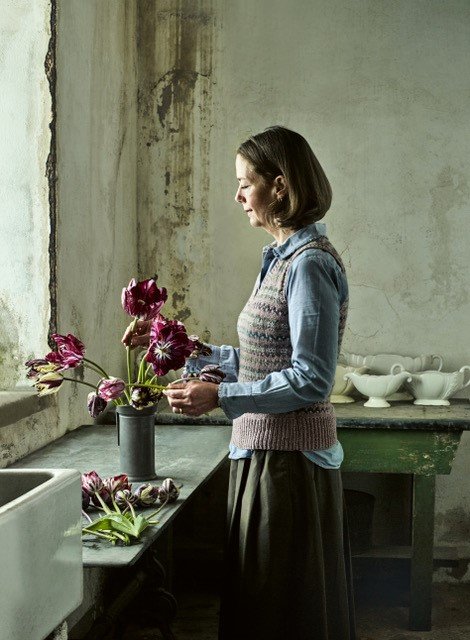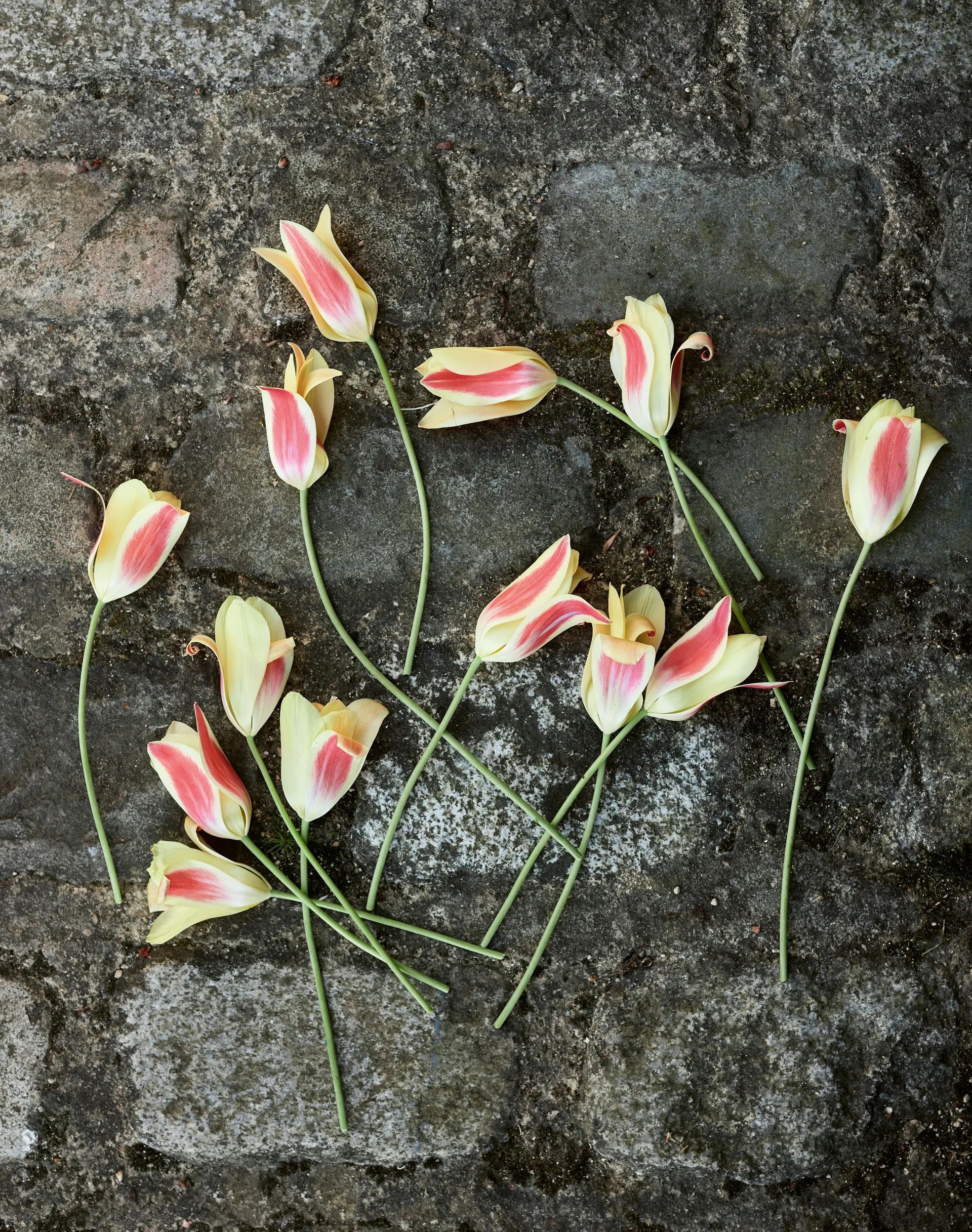House & Garden | Tip Top Tulips: Polly Nicholson On Her Passion For The Flowers
Words by Polly Nicholson
Photography by Andrew Montgomery
April 9, 2024
To coincide with the publication of her book The Tulip Garden, specialist organic grower Polly Nicholson shares her passion for these blooms. She has cultivated them in her Wiltshire garden for the past 15 years, forming a national collection and a thriving flower farm.
Polly arranging a selection of her historic tulips in her coach-house flower room.
My first experience of growing tulips was in the autumn of 2008, when we moved to Blacklands, in Wiltshire. It consisted of selecting a few varieties randomly from a mainstream gardening catalogue, planting the bulbs in some empty herbaceous beds and then feeding them with a synthetic fertiliser when they came into growth. I cannot say that a great deal of thought went into the process (and there was certainly little consideration for the environment), but the resulting display the following spring had a profound effect on me – and an obsession was born.
Fast forward 15 productive years and tulips have now taken over my life and the garden. I have a small, specialist flower farm, Bayntun Flowers, and have established a collection of over 100 different cultivars of historic tulips, dating back to 1595, which Plant Heritage has designated the National Collection of Tulipa (historic) – formed of both Dutch Historic and English Florists’ Tulips. We are certified organic with the Soil Association and strive to work in harmony with the land we live on and the wildlife it supports. Permanent plantings of species tulips have been established in gravel and grass locations throughout the garden, and we have created perennial schemes of annual tulips in meadow settings that border the driveway.
A selection of Dutch historic breeder and broken tulips in vintage French salt-glazed jugs.
Tulips specifically for cutting are cultivated in a flower field, alongside the historic collection tulips, which are sacrosanct and rarely get picked. I rotate the beds on an annual basis, use green manures to cleanse and condition the soil, and feed it with organic seaweed. I concentrate on quality and diversity, rather than quantity, and source interesting varieties in unusual, moody hues. Almost a dozen different ‘blacks’ (never a true black, which has forever been the holy grail of breeders) are planted in blocks that merge – ombré style – into each other. ‘Continental’, a deep, glossy maroon Triumph division cultivar, drifts into the multi-headed single late ‘Ronaldo’ followed by ‘Black Hero’, the most densely petalled of double tulips, until the blacks reach a range of apricots and peaches, with which they blend beautifully, both in the field and when cut and arranged together.
Others, such as the so-called French tulips with names like ‘Menton’, ‘Avignon’ and ‘Dordogne’, are chosen for their saturation of colour – often in glowing shades of apricot, coral, orange and pink – and extreme stem length (up to 75cm), and I am especially attracted to tulips with different forms: lily-flowered varieties with elegantly waisted petals that come to a sharp point at the tip, coronets (shaped like a crown, as the description implies), and feathered and twisted parrot tulips.
T. ‘Annika’ is a cultivar of T. clusiana – it emerges with pale yellow petals tinged with pink and ages to a much deeper pink.
Tulipa aucheriana, a tiny species tulip with semi-translucent rose-pink petals, ideal for pots.
In the walled gardens around the house, the beds of mixed perennials are studded with species tulips. The traditional approach would have been to plant hybrid tulips through these beds, digging them up each summer to be followed by plantings of new bulbs in the autumn. However, I find this effect too municipal. I prefer instead to use more delicate species varieties, which can be left in the ground once planted, to form drifts that meander gently through the borders rather than marching across them in serried ranks. (Though I do make an exception for the rose garden, where a mix of hybrid tulips including ‘Virichic’, ‘Request’, ‘Greenstar’ and ‘Black Hero’ has been left for the past few years.) ‘Peppermintstick’, a joyful, candy-striped clusiana hybrid, is a species tulip originally hailing from the foothills of the Himalayas, but it seems equally at home under the goblet-trained pear trees in the walled garden. And Tulipa orphanidea Whittallii Group (syn. T. whittallii) has taken happily to the pool border.
In the further reaches of the open garden, some very well established clumps of T. aximensis and T. sylvestris inhabit a group of woodland island beds and surrounding grass, and we are experimenting with plantings of ‘Little Beauty’, ‘Norah’ and T. turkestanica in gravel. However, if you do not have the space, soil or aspect for naturalised schemes – for they are not always straight-forward to grow in the open garden – I would strongly advocate using them in containers, where the growing medium and irrigation can be more readily controlled. During the months of March and April, the garden is dotted with pots of species tulips, which provide colour and interest early in the season. There is nothing like the appearance of rose-pink T. aucheriana, shaped like a miniature water lily, the loose form of knicker-pink ‘Annika’ with its distinctive purple central blotch, or the circus-style yellow and red striped ‘Tinka’ to bring joy on a cold spring day.
Set off by a fluted terracotta pot, T. clusiana ‘Cynthia’ has slender pink blooms and narrow grass-like leaves.
‘Antarctica Flame’, ‘Disaronno’ and ‘Havran’ tulips fill a large pot.
While our pots of species tulips in the walled garden tend to be small scale – in keeping with the delicate proportions of the flowers – the many vintage containers of annual tulip combinations that we create anew each year are super sized. These can each hold as many as 100 tulips, sometimes incorporating historic varieties, such as the mahogany-brown and bronze ‘Dom Pedro’, which dates from 1911. I justify their scale on the basis that I recycle many of the bulbs. Once they have finished flowering, they are left in situ for a few weeks to start dying back, before they are pulled up and dried in racks undercover.
Come late autumn, I strip off the desiccated foliage and separate any small bulblets (also known as offsets) from the main mother bulb. I then replant them all in the grass along the driveway, adhering to established colour schemes in some areas and planting them dolly-mixture style in others. The flowers will be significantly smaller for the first year or two, before bulking up or dwindling away if not happy. I have come to prefer this more natural, relaxed effect – though I do supplement key plantings with a percentage of new bulbs each year, in order to guarantee a pleasing display for visitors to our National Garden Scheme open days or workshops each spring.
Polly grows annual tulips in the cutting field on a rotation basis, alongside her historic collection tulips, using green manures and seaweed fertilisers to improve the soil. She selects varieties with interesting form and colour that make excellent cut flowers, such as peachy pink T. ‘Apricot Parrot’, densely ruffled burgundy-gold T. ‘Nachtwacht’ and moody dark-hued ‘Ronaldo’ and ‘Continental’.
Having a garden full of tulips each spring does not mean having to sacrifice environmental principles. It can be achieved without having to resort to pesticides, herbicides or artificial fertilisers. By cutting down on numbers (this also helps to prevent the fungal disease botrytis tulipae known as tulip fire – a risk in warm, wet years like 2023), using species tulips in lieu of annuals in herbaceous plantings, and reusing container bulbs in perennial planting schemes, tulips can feature in your garden without inducing environmental guilt for almost three months of the year. This is from the appearance of the first species varieties in early March right through to the historic cultivars that flower late into May. Be warned, however, that tulips can become addictive – but growing them is so richly rewarding and they give back in spades.
Bayntun Flowers: bayntunflowers.co.uk; @bayntunflowers.
Polly Nicholson’s book: ‘The Tulip Garden: Growing and Collecting Species, Rare and Annual Varieties’ (Phaidon, £29.95).
The rose garden in spring, with tulips including pink and green ‘Virichic’, inky purple ‘Black Hero’, bronze-apricot ‘Request’ and lily-flowered ‘Greenstar’.
An area by the driveway has been planted with a mixture of annual and species tulips to perennialise in the grass.
Tolerant of most soil conditions, T. humilis ‘Norah’ has elegant goblet-shaped pink blooms.
The starry white petals of delicate T. cretica ‘Hilde’ are tinged with pink.
T. ‘Tinka’ has yellow petals streaked with red.
The pale blooms of Tulipa turkestanica, a delicate species tulip with up to nine flower heads on each plant.
April 9, 2024 | House & Garden













